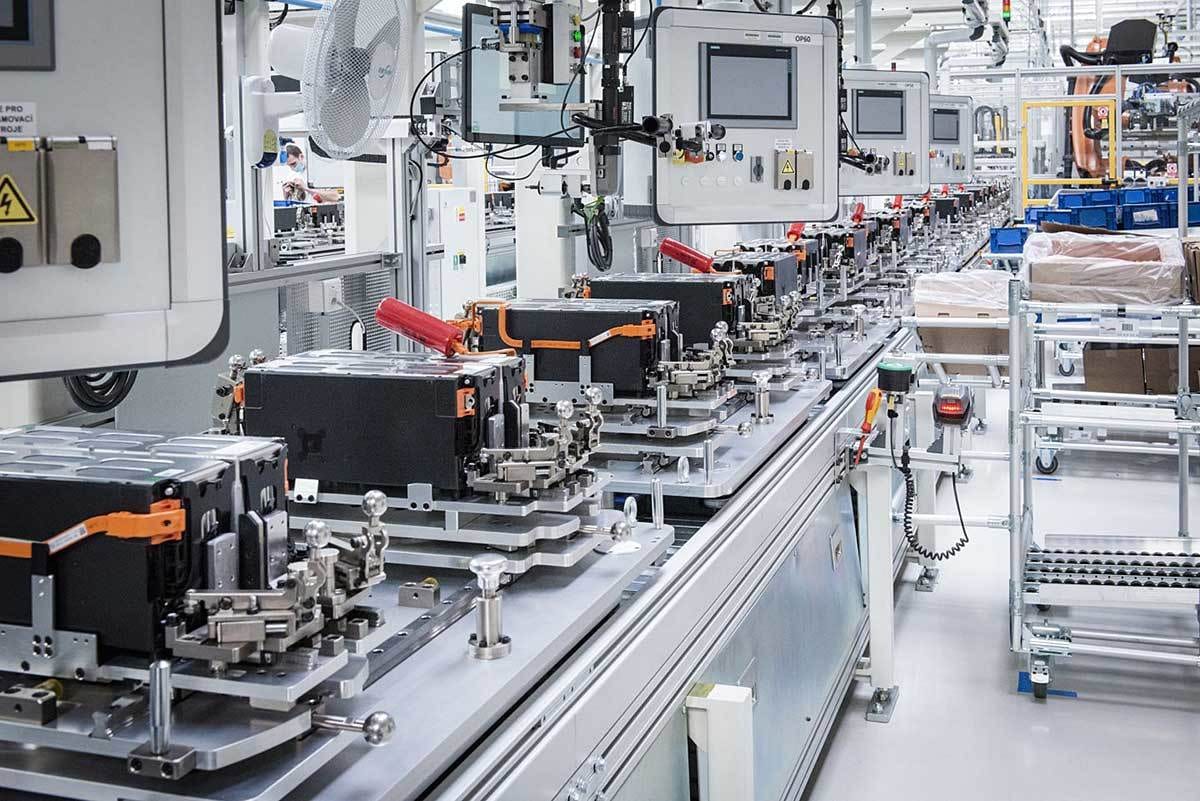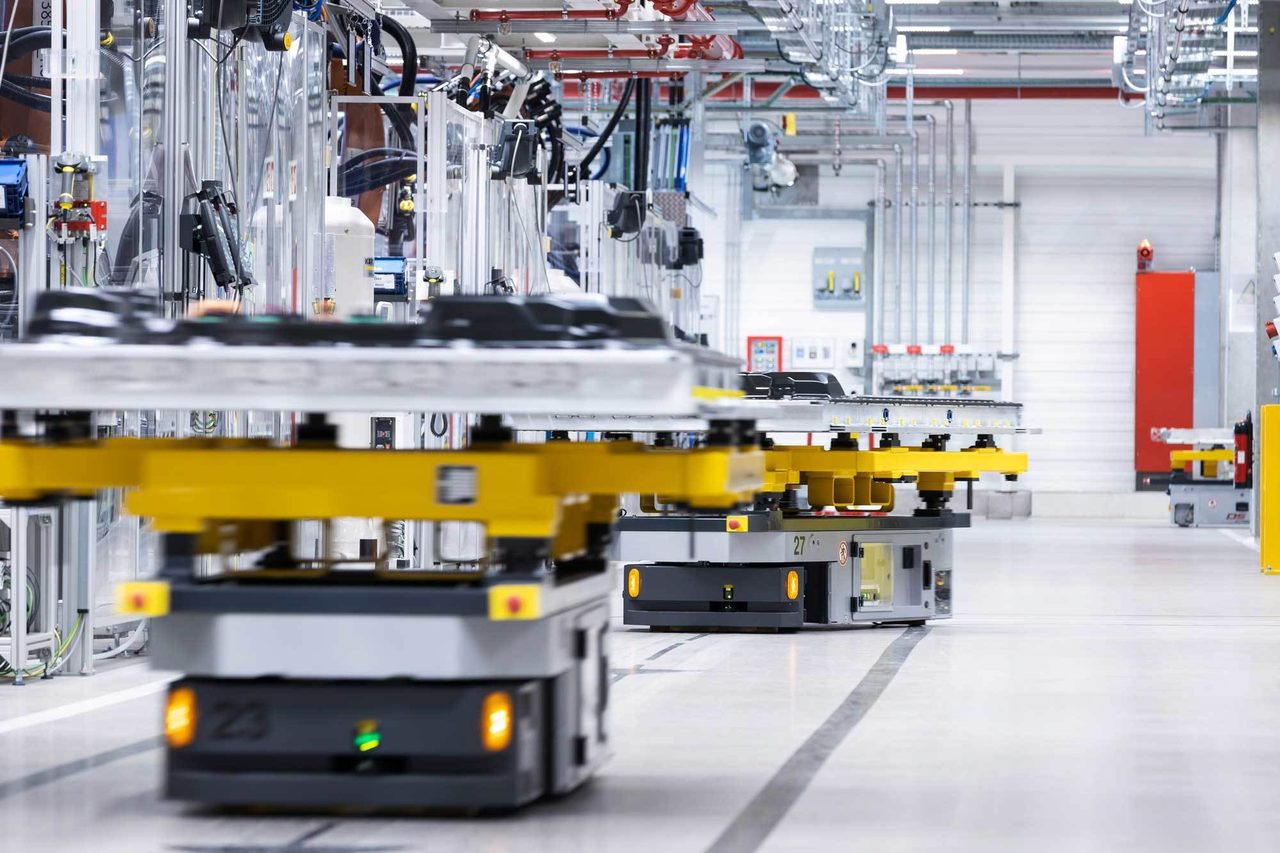
Fast, flexible automation can maximize throughput.
Gigafactories Help Battery Manufacturers Meet Growing EV Demand
John Miles // Global Head of Future Mobility // Rockwell Automation
More than 100 battery gigafactories will be needed over the next decade to meet skyrocketing demand for electric vehicles. Illustration courtesy Ford Motor Co.
Over the next decade, tens of millions of batteries will be necessary to keep up with skyrocketing demand for electric vehicles. A new breed of supersized battery factories must deploy state-of-the-art automation while harnessing advanced supply chain strategies.
While EVs represent less than 3 percent of all new vehicle sales today, that figure is expected to skyrocket to almost 60 percent by 2040. During the next five years alone, global production capacity for batteries will need to more than triple to meet the world’s estimated EV production target.
If you help run one of the many EV battery megafactories or “gigafactories” that are in operation today, or you’re helping launch one of the more than 100 gigafactories that are projected to be needed over the next 10 years, you may feel confident that this goal will be met.
However, delivering the billions of watts of energy that EVs will need in the coming decades will require more than scaling up traditional production techniques. It will also require adopting new ways of thinking about manufacturing processes to maximize speed, flexibility and throughput. This includes investing in automation and utilizing new Industry 4.0 technologies, such as digital threads and intelligent conveyance systems.
Keeping up with growing EV demand while also accommodating changes in battery technology will require flexible assembly lines. Photo courtesy Webasto Group

Intelligent Conveyance
Keeping up with growing EV demand, while also accommodating changes in battery technology, will require flexible assembly lines. Traditional conveyance systems may only slow you down.
For decades, automotive manufacturers have relied on chain-based conveyors to advance parts through the production process. These systems use motion-control technologies with hundreds of mechanical parts, like rotary-driven chains, belts and gear boxes. Moving large parts across the factory floor can result in unforeseen safety incidents and transportation inefficiencies.
These fixed systems have limited flexibility, as well as operational speeds and maintenance requirements that may fall short of your gigafactory’s needs. A better alternative is a motion control system with independent cart technology.
Independent carts that ride on a roller-supported flexible track give you control over positioning. They also enable you to put multiple products in different package and format sizes on the same line, utilizing integrated position sensing to allow individual control of separate carriers on a loop-style track.
Independent cart conveyance systems rely on linear motor technology. Linear synchronous motors (LSM) use electromagnetic force to index carriers more quickly and efficiently than traditional conveyance systems. Linear motors use components that don’t wear or come into contact with one another, which drastically reduces maintenance needs and decreases downtime.
The system’s capabilities range from individual cell sorting to full battery module and pack assembly, while also performing required testing. The machine incorporates linear servo motors that position loads in precisely the correct direction at high speeds. And changeovers simply involve selecting the correct mode from the operator interface.
Free from the constraints of a traditional conveyor, this system can improve your operations by helping you create faster, more flexible battery lines using independent, programmable movers. Time to market is improved by new LSM technology thanks to built-in full-line simulation capabilities that include an integrated track-and-trace system that eliminates the need for external sensing.
Intelligent conveyors also reduce changeover times with simple software profiles that allow you to change products just by pushing a button. The software houses comprehensive code libraries that reduce program complexity, making vehicle routing more straightforward. Anti-collision programming and automated queuing are built-in, increasing both safety and efficiency.
Fewer moving parts also means higher machine reliability. These systems can mitigate maintenance-related downtime by reducing the probability of widespread issues.
While gigafactories have a large physical footprint due to their production output, that doesn’t mean the plants have space to spare. Linear synchronous motors offer a 20 percent to 30 percent reduction in floor-space and eliminate the need for buffer zones. That can help increase production efficiency and better meet swiftly increasing demand for EV batteries as more factories become operational.
A digital thread is weaved using data from smart machines and digital twins. Illustration courtesy Rockwell Automation/Shutterstock

In addition to LSM technology and independent cart systems, engineers interested in intelligent conveyance should consider adding autonomous guided vehicles (AGVs) to their gigafactories. AGVs are information-enabled machines that perform material handling tasks via routing data from your manufacturing execution system (MES).
AGVs can navigate freely throughout a facility without human intervention, providing real-time data while undertaking tasks such as transporting pallets, rolls, racks and other important materials. AGVs can be used throughout the production process, from transporting raw materials out of storage to handling finished products ready for shipping.
Although an intelligent conveyance system can provide innumerable benefits to a gigafactory’s efficiency, productivity and throughput, the real impact is delivered by connecting that system to the factory’s other digital assets.
Digital Threads
As the EV industry projects unprecedented growth through the next several decades, battery makers must continuously scale and improve their operations to meet that demand. With such a fast-growing industry, the ability to innovate and bring products to market quickly is crucial.
A digital thread is one of the most effective ways engineers can continue to learn from and fine-tune their production process. It is a continuous flow of information that turns insights into actions and connects previously siloed business functions, improving their ability to work together. A digital thread is weaved using data from smart machines and digital twins to deliver valuable insights into your facility’s capabilities.
Digital twins reduce upfront investment in physical manufacturing capabilities for battery makers. Instead, manufacturers can create virtual simulations—twins—to model prototypes and production outcomes before ever engaging with a physical machine. That enables engineers to troubleshoot issues and fine-tune their approach with less time and resources lost.
Battery manufacturers must adopt new ways of thinking about production processes to maximize speed, flexibility and throughput. Photo courtesy Skoda Auto

By speeding up design timelines and reducing the cost of troubleshooting problems, digital twins allow manufacturers to get to market more quickly and create higher quality output faster. A digital thread makes these benefits even more tangible, communicating that data between business units seamlessly.
Digital threads increase connectivity of information across business functions. Data sharing and programming makes the automation of complex processes possible, allowing engineers to focus their efforts on increasing efficiencies and optimizing other operations.
Similarly, automating other regular workflows eliminates cross-system coordination, allowing your machines to orchestrate production without requiring intensive oversight or introducing potential human error.
The high demand expected in gigafactories can also be managed more effectively when the issues of timeliness and employee workload are mitigated by automation. This lights-out approach utilizes data and machine learning to download and execute orders with little to no human intervention. While an expert workforce is a critical part of meeting EV demand, fully automated capabilities are an important resource when scaling production.
Engineers interested in intelligent conveyance should consider adding autonomous guided vehicles to their gigafactories. Photo courtesy Daimler AG

Maximizing Productivity
A digital thread is an important tool in maximizing productivity within a factory’s workforce. Engineers can use augmented reality technology to improve standard operating procedures by documenting and sharing process information. This documentation can also be an important tool in on-the-job training for new operators.
In today’s connected world, many manufacturers rely on operators across the world to maintain the success of their entire enterprise. Several leading automakers have announced plans to build gigafactories in multiple states or countries, making seamless collaboration a priority regardless of location to ensure consistency.
With digital thread technology, important data and insights are available across all facilities, giving operators the resources to problem-solve effectively. This empowers teams with differing skillsets to learn from each other, strengthening an organization’s workforce across the board.
An MES is one popular way to harness your digital thread, because the software allows you to integrate your control and business systems to execute and track orders across your enterprise. The program can also gain the additional context needed to turn production data into actionable information, thanks to the large amounts of data provided by a digital thread.
With this integration, the technology is also scalable to manage specific site needs and goals. For example, within an MES, a quality application can be utilized to track, identify and alert management when a machine or operator’s processes go outside of their prescribed limits, stopping a problem before it impacts production on a larger scale. A track-and-trace application can also be applied to gain complete traceability of batteries through the manufacturing process.
A digital thread is the key to operating a factory of the future. By implementing one in your gigafactory, your facility will reach its full potential.
The fast-growing EV market requires highly efficient, flexible and data-driven assembly plants that can produce batteries in high volumes, at high speeds and at a consistently high quality.
Not only does this require battery makers to scale their operations, but it presents the industry with an opportunity to design and build a new class of digitalized smart manufacturing facilities that set the stage for the future of sustainable production.
DECember 2021 | ASSEMBLYMAG.com

Scroll to
read full story

